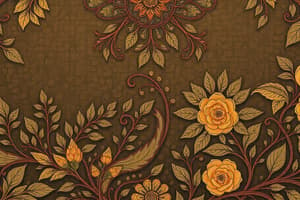Podcast
Questions and Answers
What does the strict equality operator (===) evaluate?
What does the strict equality operator (===) evaluate?
- Whether two operands are equal regardless of type
- Only the value of two operands
- Only the type of two operands
- Whether two operands are identical in value and type (correct)
What will the expression 100 == '100' evaluate to?
What will the expression 100 == '100' evaluate to?
- True, as it only checks value equality (correct)
- False, as the value is a string
- False, due to type differences
- True, since both are numbers
When is the strict inequality operator (!==) utilized?
When is the strict inequality operator (!==) utilized?
- To compare two values for equality only
- To determine if two values are identical, including types (correct)
- To confirm whether two values differ in value only
- To check if two values are not the same regardless of type
What will the expression 1 !== '1' return?
What will the expression 1 !== '1' return?
Which of the following represents the correct difference between != and !==?
Which of the following represents the correct difference between != and !==?
Flashcards
Boolean data type
Boolean data type
A data type that can only hold two values: true or false.
Equality operator (==)
Equality operator (==)
Checks if two values are equal, ignoring data type.
Strict equality operator (===)
Strict equality operator (===)
Checks if two values are equal and have the same data type.
Inequality operator (!=)
Inequality operator (!=)
Signup and view all the flashcards
Strict inequality operator (!==)
Strict inequality operator (!==)
Signup and view all the flashcards
Study Notes
Boolean Data Type
- Boolean data type holds only two values: true or false.
- These values result from comparisons.
Comparison Operators
-
Equality operator (==): Checks if two values are equal.
-
Example: 100 == "100" returns true.
-
Strict equality operator (===): Checks both value and type for equality.
-
Example: 100 === "100" returns false (different types).
-
Inequality operator (!=): Checks if two values are not equal.
-
Example: 1 != 1 returns false.
-
Strict inequality operator (!==): Checks both value and type for inequality.
-
Example: 1 !== "1" returns true (different types).
Studying That Suits You
Use AI to generate personalized quizzes and flashcards to suit your learning preferences.




